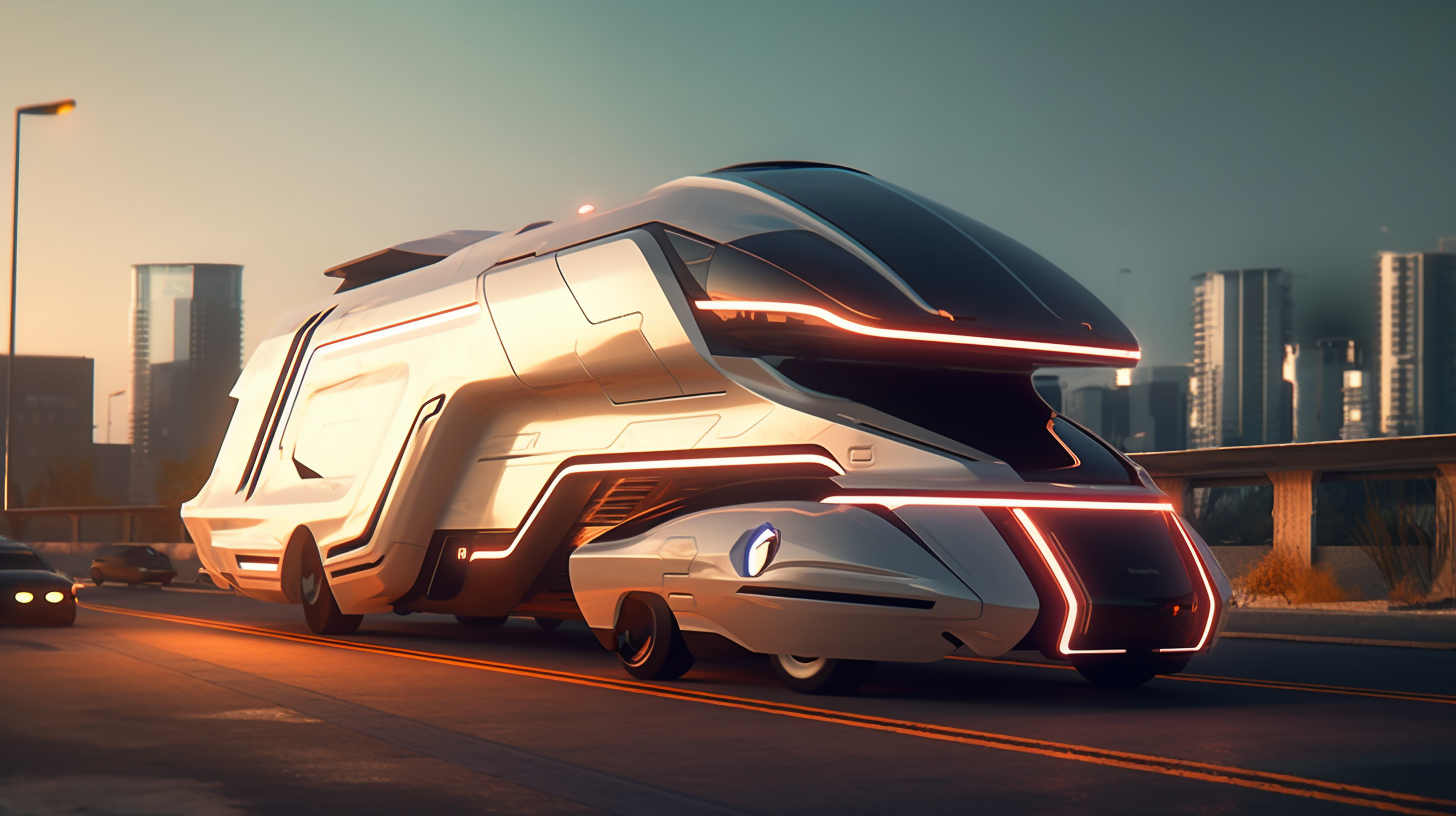RVing has become a popular way to explore the great outdoors, with many people favoring this method of travel over traditional holiday options. The rise in demand for recreational vehicles has led to rapid growth in the market, enabling manufacturers to incorporate emerging trends and technologies into their products to meet consumer demands. The introduction of novel features like smart and electric RVs, eco-friendly features, and virtual reality entertainment systems has transformed the RV industry, providing a unique travel experience for people across a wide range of backgrounds. In this article, we’ll explore some of the most significant trends and technologies that are shaping the future of RVing. So, fasten your seatbelts, and let’s get started!
The Current State of RVing
RVing, or recreational vehicle travel, has been a popular form of vacationing and adventure travel for decades. The industry has experienced a surge in recent years, with sales and rentals of RVs at an all-time high. But with growing concerns about the environmental impact of traditional gas-powered RVs and economic uncertainty, the future of RVing is being shaped by emerging trends and technologies that aim to make it more sustainable, efficient, and customer-oriented. In this article, we will explore the current state of RVing and the factors that are affecting its direction.
A Quick Overview of RVing History
RVing has come a long way since its inception, and today it is an industry that is constantly evolving. The history of RVing can be traced back to the early 20th century when entrepreneurs began to build camping trailers and caravan trailers, which were essentially small, portable homes designed for camping and travel. These early camping trailers were basic and spartan, providing little in the way of amenities or comfort.
The first true recreational vehicles (RVs) became available in the 1930s, and they were the epitome of luxury vehicles. They were designed for affluent travelers who wanted to travel in comfort and style. These early RVs were large and spacious, with bedrooms, bathrooms, and kitchens, and they were equipped with all the latest mod cons.
Over time, RVs became more accessible and affordable, and they expanded beyond the luxury market to cater to a broader customer base. As a result, RVing became more popular as a lifestyle choice, and more people began to embrace it as a way to explore the great outdoors.
Today, RVing is more popular than ever before, with a thriving industry that caters to a wide range of lifestyles and preferences. Whether you’re a family looking for an affordable and convenient way to travel, or a retiree looking to hit the road and explore the country, there’s an RV out there that’s perfect for you.
The Popularity of RVing Today
RVing has seen a significant surge in popularity in recent years, with more individuals and families embracing the RV lifestyle. The RV industry has experienced steady growth, reaching an all-time high in recent years. This trend can be attributed to several factors, including a desire for experiential travel and the flexibility that RVing offers.
One of the driving forces behind the RVing trend is the desire for experiential travel. Many people are looking for unique experiences that allow them to explore the world and create lasting memories. RVing provides an opportunity to do just that, with the added convenience of a home on wheels. It allows travelers to explore at their own pace, taking time to appreciate scenic routes, local cultures, and activities.
Another factor contributing to the growth of the RV industry is the flexibility provided by the RV lifestyle. RVers have the freedom to travel wherever they want, whenever they want, without the constraints of flights, hotels, and rental cars. RVs allow travelers to carry all the amenities of home, including a fully equipped kitchen, comfortable bed, and private bathroom, making it ideal for families with children or pets.
The RVing trend is not just limited to a specific demographic; it appeals to a diverse range of individuals and families. In fact, the demographics of RV users have been expanding in recent years, with more millennials, Gen Xers, and even retirees embracing the RV lifestyle. RVing has become increasingly popular as a way to travel affordably and sustainably.
According to the RV Industry Association (RVIA), the RV industry has seen steady growth over the past few years, with record-breaking numbers of RV shipments and sales. In 2019, RV shipments reached over 400,000 units, a 4.5% increase from the previous year. This trend continued into 2020, with RV sales remaining strong despite the economic uncertainty caused by the COVID-19 pandemic.
The Future of RVing: An Overview
The future of RVing is bright, with emerging trends and technologies rapidly shaping the industry. While the RV lifestyle will undoubtedly remain popular, the industry is likely to face new challenges and opportunities in the coming years. One major trend is the increasing demand for specialized RVs that cater to specific interests and activities, such as sports, outdoor adventures, and luxury travel. Customized RVs with built-in features such as solar panels, recycled plastic materials, and lithium-ion batteries are becoming increasingly popular among eco-conscious consumers who are looking for ways to reduce their carbon footprint.
Intelligent technologies such as artificial intelligence, virtual and mixed reality, and smart technology will also play a significant role in shaping the future of RVing. RVs equipped with these technologies will offer enhanced customer experiences, improved safety and security, and greater energy efficiency. Additionally, with the rise of autonomous technologies, RVing is poised to transform travel as we know it, with self-driving RVs that offer unparalleled comfort, convenience, and adventure.
However, the RV industry will also face new regulatory challenges in the future as governments seek to regulate the environmental impact of RVs. As regulations concerning emissions and fuel efficiency become stricter, RV manufacturers will need to develop new technologies that offer greater energy efficiency and lower carbon emissions. The RV industry will also need to address the challenges of economic uncertainty, changing consumer preferences, and evolving business cycles.
Emerging Trends in the RVing Industry
The RVing industry is constantly evolving, with emerging trends and technologies shaping the way we travel. From smart technology to environmental impact, the future of RVing promises new and exciting developments. In this article, we explore some of the key trends that are set to transform the industry and the challenges that come with these changes.
Eco-Friendly RVs
The future of RVing is slowly transitioning towards a more eco-friendly direction, with a growing awareness of the environmental impact and the need for sustainability. Eco-friendly RVs, also known as green RVs, are designed to reduce the environmental impact of traditional gas-powered RVs by using sustainable materials and innovative technologies that promote energy efficiency.
One of the most notable features of eco-friendly RVs is the use of solar panels. These panels convert sunlight into electricity, which can then be used to power the appliances and amenities within the RV. This technology not only cuts down on the need for traditional power sources but also allows RVers to enjoy off-the-grid camping without sacrificing their modern conveniences.
Another feature that eco-friendly RVs incorporate is composting toilets, which eliminate the need for traditional black water tanks and chemical treatments. Composting toilets break down waste into nutrient-rich compost, which can then be safely disposed of or used as fertilizer. This technology drastically reduces the environmental impact of RV waste and allows RVers to camp more sustainably.
In addition to using sustainable and recycled materials, eco-friendly RVs also use bamboo, cork, and recycled plastic. These materials reduce the carbon footprint of the RV manufacturing process and promote a more circular economy.
Some specific eco-friendly RV models that are currently available on the market include the Winnebago Travato Pure3, which has a built-in lithium-ion battery system and solar panels for off-the-grid power, and the EarthRoamer LTi, which is built with fully recyclable and sustainable materials.
The benefits of eco-friendly RVing go beyond just reducing environmental impact. The use of solar panels and composting toilets can also lead to significant cost savings, as they eliminate the need for traditional power sources and waste disposal fees. Additionally, the use of sustainable materials in RV construction can lead to a longer lifespan and increased durability, resulting in less waste and more efficient use of resources.
Overall, the concept of eco-friendly RVs is becoming increasingly important in the RV industry as more consumers prioritize sustainability and environmental impact. With innovative technologies and sustainable materials, eco-friendly RVing is poised to become a game-changer in the entire RV industry.
Luxury RVing and Customization
In recent years, the world of RVing has seen a growing demand for upscale and specialized vehicles, resulting in the emergence of luxury RVs. These high-end vehicles offer a range of unique features and amenities that set them apart from traditional RVs, making them an appealing option for those seeking a luxurious and customizable travel experience.
Luxury RVs often prioritize comfort and luxury, with resort-inspired designs featuring premium finishes and high-end appliances. They also tend to have larger living spaces, custom cabinetry, and advanced entertainment systems, from large flat-screen TVs to high-quality audio systems.
But it’s not just about creature comforts. Luxury RVs can also offer advanced off-road capabilities, allowing travelers to explore remote or rugged destinations with ease. They can come equipped with heavy-duty suspensions, powerful engines, and extra fuel tanks for extended trips.
And of course, as with any cutting-edge technology, advanced features and amenities are a given. Luxury RVs often have the latest in smart technology, including touchscreen panels, remote monitoring systems, and energy-efficient lighting. Some even feature built-in solar panels, reducing their carbon footprint and allowing for sustainable travel.
Manufacturers are investing heavily in new and innovative designs to meet the demands of the luxury RV market. The trend towards customization means that every vehicle is unique, as customers can select from a wide range of options to create their ideal travel experience.
Overall, the luxury RV market has seen impressive growth in recent years, driven by a desire for exceptional travel experiences and the ability to customize every aspect of the journey. As the market continues to expand, we can expect to see even more resort-inspired designs, cutting-edge technologies, and off-road capabilities in these high-end vehicles.
Technological Advancements Shaping the RV Industry
The RV industry has seen significant advancements due to emerging trends and technologies. From the latest in smart and sustainable technologies to cutting-edge features, RV manufacturers are constantly investing in innovative designs to meet the changing needs and preferences of consumers. These technological advancements are transforming the industry and influencing the future of RVing.
Solar Power Integration in RVs:
The future of RV travel is looking brighter and more sustainable than ever before, as solar power integration becomes increasingly popular. Solar panels, which harness energy from the sun, offer numerous benefits for RV owners and travelers. By utilizing this eco-friendly energy source, RVers can reduce their carbon footprint and live off-the-grid, while still enjoying all the comforts of home.
One of the primary benefits of incorporating solar panels into an RV is the ability to power various aspects of the vehicle, including lights, appliances, and even air conditioning units. This means that RVers can travel to remote locations without relying on traditional gas-powered generators or extended stays at RV parks. By generating their own electricity, RVers can explore nature and enjoy the freedom of off-the-grid living.
In addition to solar power, some RVers are also looking to incorporate wind turbines into their vehicles. While solar panels are highly effective in sunny locations, wind turbines are capable of generating energy in areas with higher wind speeds. This can be particularly useful for RVers who enjoy traveling to coastal regions or mountainous areas where the wind is plentiful.
Another exciting potential for the future of RV travel is improved battery technology and integration. Currently, RVs typically rely on traditional lead-acid batteries which can be heavy and less efficient. However, advancements in lithium-ion battery technology provide improved efficiency and lighter weight. Additionally, regenerative braking technology can help charge RV batteries while in transit, providing an extra source of power.
As the RV industry continues to evolve, it’s clear that solar power integration will be a game-changer for the entire industry. With the potential to drastically reduce carbon footprints and offer off-the-grid living, solar-powered RVs are sure to be a hit with adventurers and eco-conscious travelers alike.
Internet of Things (IoT) and Smart RVs
The world of RV travel is being transformed by the latest technologies, including the Internet of Things (IoT) and smart RVs. With IoT, RVers can enjoy a more connected and streamlined travel experience by accessing and controlling various RV systems through their smartphones or tablets. From improved comfort to enhanced security, IoT technology is revolutionizing the RV industry in exciting ways.
Smart RVs come equipped with touchscreen control panels that allow travelers to control and monitor everything from lighting and temperature to entertainment systems. With mobile app integration, RVers can access information about their RV’s systems and easily troubleshoot any issues from their smartphone. On-board Wi-Fi assures continuous connectivity and the ability to stream movies, music, and video calls, enhancing travel experiences.
In addition to these basic features, smart RVs can be integrated with a range of IoT devices to further improve the travel experience. Thermostats can be adjusted remotely, ensuring optimum conditions in the RV. Smart security systems provide real-time alerts for any unauthorized entry, while smart locks provide added convenience, letting RVers lock and unlock their doors using their mobile app. Smart kitchen appliances, such as refrigerators and ovens, allow for improved meal planning and preparation.
Another exciting benefit of IoT technology in smart RVs is the ability to prevent potential breakdowns and maintenance issues. Real-time monitoring of various RV systems, such as the engine, battery, and tire pressure, can provide RVers with alerts, allowing them to respond to potential problems before they become serious. This feature can save RVers time and money while providing peace of mind on the road.
Lightweight and Durable Materials
In the past, RVs were often seen as gas-guzzling beasts that were difficult to maneuver on the roads. However, with the emergence of lightweight and durable materials, the RV industry has seen a significant improvement in fuel efficiency and maneuverability.
One of the most popular materials that RV manufacturers are using is aluminum. Not only is aluminum lightweight, but it is also durable and corrosion-resistant. Additionally, aluminum can be recycled, making it an eco-conscious choice for RV manufacturing. Composite materials, such as fiberglass and carbon fiber, are also gaining popularity in the industry. These materials are lightweight and strong, making them ideal for RV construction.
In addition to improving fuel efficiency and maneuverability, RV manufacturers are also incorporating sustainable and environmentally-friendly materials into their products. Bamboo is a popular material that is being used in RV flooring and cabinetry due to its strength and sustainability. Recycled plastics are also being utilized in RV construction, including for exterior panels and furnishings.
Low-VOC paint is also becoming more common in RV manufacturing. This type of paint has lower levels of volatile organic compounds, which can be harmful to both the environment and human health. Using low-VOC paint helps reduce the RV’s carbon footprint and improves consumer safety.
The use of these lightweight, durable, and eco-friendly materials is in response to consumer demand for more sustainable and environmentally-conscious products. RV manufacturers want to appeal to the growing number of consumers who are concerned about their impact on the environment. As a result, RV manufacturers are making strides to improve the fuel efficiency and eco-friendliness of their products while maintaining their durability and strength.
Challenges and Opportunities in the Future of RVing
The future of RVing is rapidly evolving, presenting both challenges and opportunities for manufacturers, consumers, and the overall industry. Technological advancements and innovative design are making RVs more sustainable, efficient, and connected, but there are also regulatory hurdles and economic uncertainties that must be navigated.
One key challenge facing the RV industry is keeping up with regulations. As governments around the world continue to prioritize environmental sustainability, RV manufacturers must adapt to new emissions standards and incorporate eco-friendly materials into their products. Regulations regarding safety and driver assistance features are also evolving, making it essential for manufacturers to remain up-to-date on the latest requirements.
However, these challenges also present opportunities for increased innovation and customization in RV design and technology. For example, advancements in autonomous technologies could allow for safer and more efficient travel, while also enabling greater customization options for consumers.
On the sustainability front, eco-friendly advancements in RVs are likely to become commonplace in the near future. Built-in solar panels, lithium-ion batteries, and more efficient battery systems are paving the way for more environmentally-friendly RVs. Recycled materials and more efficient heating and cooling systems are also being explored.
In terms of consumer preferences, the COVID-19 pandemic has led to a resurgence in RVing, as people seek safe and socially-distanced travel options. Additionally, as millennials and Gen Z become more interested in adventure travel and outdoor experiences, there is an opportunity for RV manufacturers to capture a new customer base.
However, market conditions and economic uncertainty could also impede the industry’s growth. The RV industry, like many others, will have to navigate these challenges as they arise. Despite this, the outlook for RVing remains bright, as continued innovation and growth are expected.
Conclusion
In conclusion, the future of RVing is grounded in innovative technology and a growing emphasis on sustainability. RV manufacturers who prioritize eco-friendly design and smart technology will be well-positioned to meet the needs of an increasingly diverse customer base. This includes younger travelers seeking unique outdoor adventure experiences, retirees looking for comfortable and efficient travel, and female RVers who are claiming their place in the industry.
As the RV industry evolves, manufacturers are also exploring new ways to provide custom and specialized options, from lightweight models designed for easier towing to specialized RVs with built-in amenities for niche interests. Additionally, the growth of the RV rental market presents a new avenue for RV manufacturers to reach customers who want the experience of RV traveling without the financial commitment of owning their own vehicle.
By staying attuned to changing consumer preferences and offering innovative solutions, RV manufacturers can continue to drive industry growth and deliver exceptional experiences for all types of travelers. The future of RVing is bright, and those who embrace these trends will be positioned to thrive in an industry that has the potential to change the face of leisure and adventure travel for years to come.





